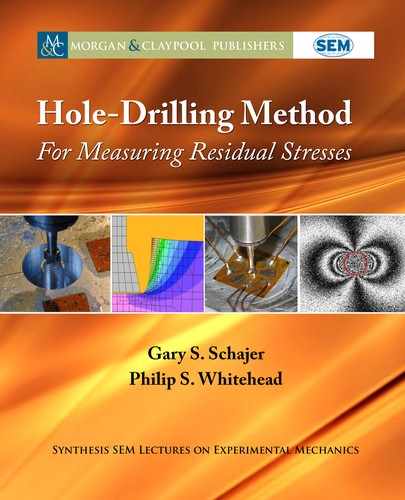
47
C H A P T E R 3
Hole-Drilling Method
Concept and Development
“e new test method ... is done by drilling a hole, which, however, is so small that the part can
be used again.”
Josef Mathar (1934) in Determination of Initial Stresses by Measuring the Deformations
Around Drilled Holes.
3.1 INTRODUCTION
e Hole-Drilling Method has an extensive history dating back to the 1930s. It has developed
into a modern residual stress measurement technique that uses state-of-art technology to enable
non-specialists to achieve accurate results consistently and reliably. is state of development
has been achieved through the accumulation of many individual advances by numerous workers
over the years. is chapter gives an overview of the operational concept and the historical
development of the Hole-Drilling Method from the early explorations to contemporary detailed
knowledge.
3.2 CONCEPT
e Hole-Drilling Method involves drilling a small hole in the material specimen at the desired
test location. e removal of stressed material within the hole causes a stress redistribution in the
material surrounding the hole. is stress redistribution, or “relaxation,” creates localized elastic
deformations in that material. Figure 3.1 schematically illustrates the outward deformations
around a hole drilled into material with tensile residual stresses. ere is also a small local surface
rise caused by the action of Poisson’s ratio; the reverse happens in the presence of compressive
stresses. In practical measurements, the relaxation deformations of the material around the hole
are measured using strain gauges or by optical techniques. Specialized calculation procedures
are then used to evaluate the residual stresses that originally existed within the hole from the
measured deformations.
e closely related Ring-Core Method reverses the geometry of the Hole-Drilling
Method by placing the measurement area in the middle and making the “hole” in the form
of a surrounding annular groove. Figure 3.2 compares the geometry of the Hole-Drilling and

48 3. HOLE-DRILLING METHOD CONCEPT AND DEVELOPMENT
(a) (b)
Strain Gauge Hole Location
Figure 3.1: Schematic cross-sections around a hole drilled into tensile residual stresses. (a) Before
hole drilling and (b) after hole drilling.
(a) (b)
Strain Gauge Rosette Strain Gauge Rosette
Hole Ring Core
Figure 3.2: Residual stress measurement methods. (a) Hole drilling and (b) ring-core.
..................Content has been hidden....................
You can't read the all page of ebook, please click here login for view all page.
